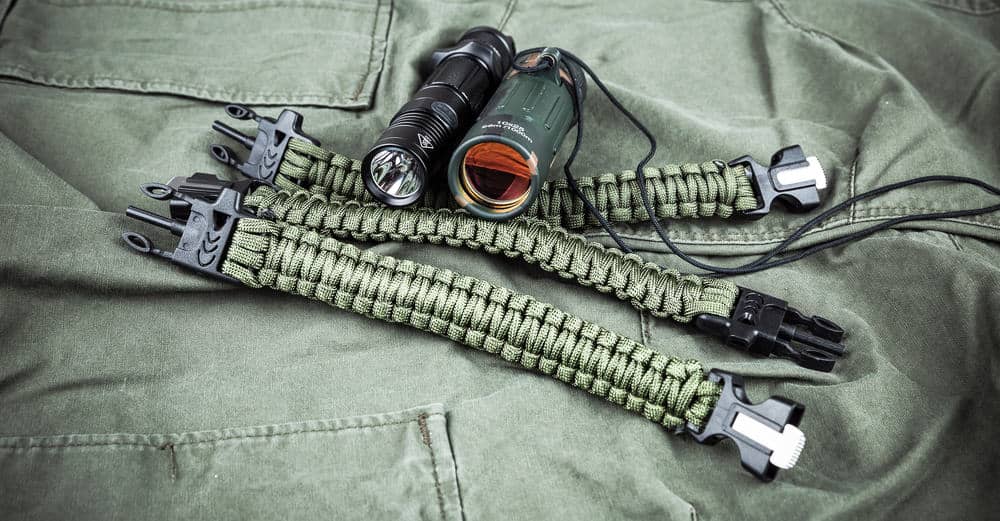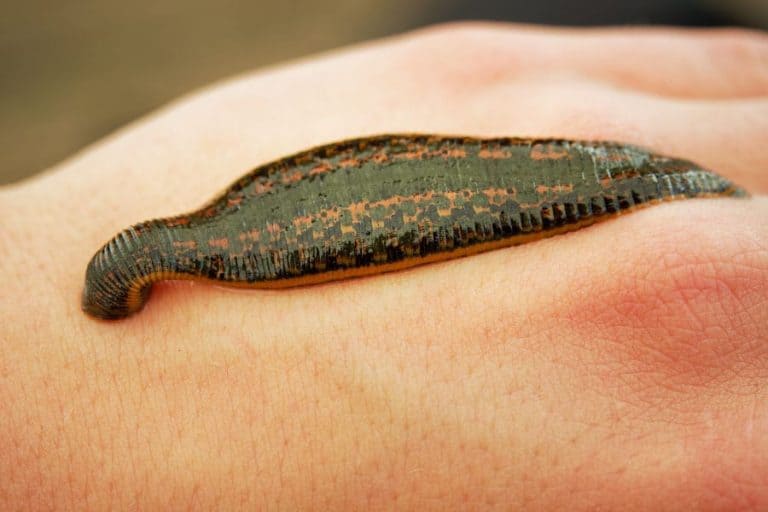Emergency Paracord Bracelet
Many people wear a paracord bracelet, some just because they like it, and others because they know its potential in a survival situation. Have you considered how to use an emergency paracord bracelet? Would you know how to use it if and when you need it?
A paracord bracelet has many applications in an emergency or survival situation. It can be used as a ridgeline for making shelter, a tourniquet to stop bleeding, or strapping a broken limb. It can be used for making snares and straps, for fishing and hunting applications, and fire-making. You can even use it to repair damaged gear or stitch ripped clothing!
We have put together some information on this extremely useful survival accessory so you can better understand its potential usefulness in many situations, not only for emergency situations!
Before we get into some uses for the paracord bracelet, let’s discover what it is made from.
What Is Paracord?
The name paracord comes from the original function of this type of cordage. It was used primarily as the cords that attached a parachute to its harness and were used extensively for this purpose in World War 2. Paratroopers would often cut the cordage from their chutes once they had landed and carried it with them due to its usefulness.
Up until this time, paracord was strictly used by the military but was made available to the public as military surplus after World War 2. Since the public has had access to this material, it has been used for many different applications and has become popular cordage in the outdoor and survival community.
It is often referred to as 550 paracord, which stems from its ability to carry a load weight of 550lb. Paracord is constructed with an outer nylon sheath with between 7 and 9 inner nylon strands. Each of these inner nylon strands is, in turn, made from 2 to 3 nylon threads that are woven together.
I am sure you can see from its construction how useful this material can be and the many ways it can be improvised to use in many different situations. The versatility of this material was proven when it was used by astronauts in the repairs made to the Hubble Telescope!
Why Wear It As A Bracelet?
Paracord can, believe it or not, become quite bulky to carry. It is also not convenient to carry a length of it wadded up in your pocket. Weaving it into a bracelet is a way of making it easy to carry a length of it around as an everyday carry item (EDC).
A paracord bracelet can have anywhere from 2.4 meters to 6 meters (8 to 20 feet), depending on the size of the bracelet and the weave used. A small bracelet that I made for my wife, using the standard cobra weave, has 3 meters (10 feet) of paracord in it.
The buckles, clasps, and clips used to fasten the bracelet around your wrist can also have many survival uses. Many manufacturers have come up with inventive ways of incorporating useful items into the buckle. The one I wear has a compass and small survival whistle built into it as well as a small Ferro rod and striker for fire-making.
Let’s get onto some ideas on how the bracelet can be used in a survival situation.
Uses For An Emergency Paracord Bracelet
The uses for paracord in the outdoors are many and varied and only limited by your imagination, ingenuity, and improvisations skills. Even a small bracelet can have sufficient cordage on it to be useful.
To Make A Shelter
There are many instances under this category where paracord is useful, even with relatively short lengths.
A Ridge Line
A 3 meter (10 foot) length of paracord is long enough to tie between two trees as a ridgeline. You can then drape a tarp, poncho, piece of plastic over the ridgeline to create a makeshift shelter that will keep you dry and out of the wind.
If you do not have enough paracord for a ridgeline, you can cut a branch to the length you need and use it as a ridgeline. Use the paracord to lash the branch between the two trees. You can then stack branches up against this cross piece to form a primitive lean-to.
Medical Uses
I would always recommend that you go on a first aid course so that you have a basic idea of how to handle medical emergencies. Treating injuries without his knowledge can make the situation worse, especially when it comes to the use of a tourniquet.
A Tourniquet
As a life-saving measure, to stop an extensive or arterial bleed, you can tie a loop of paracord and place it over the limb above the bleeding area. Put a stick through the loop and twist the stick to tighten the paracord around the limb.
Warning: Using this technique without the proper knowledge can cause the loss of the limb due to a lack of sufficient blood supply. I must reiterate the importance of attending a first aid course to use this method correctly.
Broken Limbs
A makeshift sling can be fashioned from paracord to elevate or support a broken or fractured limb. If a splint is needed, you can cut two branches, place them on either side of the break and lash them to the limb using paracord.
Gathering Food
Paracord has a wide range of uses in this category.
Snares And Traps
There are many different traps or snares that you can fashion using paracord. Make a simple noose and position it across the trail where small animals travel. Use the paracord in the making of simple deadfall traps or spring traps; the list goes on and on!
Fishing
The inner cords of the paracord can be pulled out and joined together to make an improvised fishing line which you can wind up on a stick. Use the same inner strands to make a hook by tying a piece of wire to a small stick or lashing a strong thorn to a small stick to create the hook.
Hunting
A length of paracord can be used to string a primitive bow for hunting small game. Cut an appropriate length sapling and notch it at each end on the outer part of the bow. Tie a loop at each end of your paracord, bend the bow and place the paracord loops on each end in the notches that you made. You may need to adjust the length of the paracord to achieve the right tension in the bow.
Bird feathers, pieces of plastic, or other material can be attached to arrows as fletching by using the thin inner strands of the paracord to tie onto the shaft of the arrow. Sharp stones, pieces of bone, or other material can be attached in a similar way to make the head of the arrow.
Use the paracord to lash your knife or another sharp object to a long, stout stick to make an improvised spear. This spear can be used for fishing, hunting small game, or even self-defense if necessary.
Fire Making
Fire making is an important part of survival for purifying water, cooking food, and to provide a source of warmth. Paracord can even be employed as part of your strategy for getting a fire started!
Paracord can be used as the string in creating a bow drill to make a friction fire. Paracord can be a bit slippery when used in this manner, so you may want to double up on the paracord to make the bowstring grip the spindle better.
The inner strands of nylon can be pulled out of the nylon sheath, separated into their individual strands, and used as tinder or a bird’s nest to get your fire going.
Gear Repair and Maintenance
Gear breaks down, wears out, and gets damaged. Paracord can be used in a multitude of ways to repair items important to your survival! This is a category of paracord uses that is only limited by your creativity in fixing whatever needs to be repaired.
Stitching
The thin inner strands of nylon can be extracted from the outer shell and used as thread. This thread can then be used to stitch buttons back on clothing, sew cuts and holes on clothing, or to mend tents and tarps.
Strapping And Lashing
Paracord has an element of elasticity to it, which makes it an ideal type of cordage for lashing and strapping. When pulled tight and wrapped around an item, it will provide good tension and support.
Paracord can be used in this way to wrap around the handle of a tool that you have carved from wood or sticks, and it will give you added grip.
The wooden handle on your knife could crack or break, making it difficult to use. Remove the broken handle and wrap the tang of the knife in paracord to a thickness that feels comfortable in your hand.
Lash three sticks together at one end to make a tripod to place over your fire for suspending cooking utensils over the fire or dangling meat over the flames for cooking.
To Wrap It All Up
These are just a few examples of how an emergency paracord bracelet can be used. It is by no means a complete list, as the versatility of this material makes its uses too many to list.
I am sure that you will agree that it is a worthwhile item to have on you, and it’s disguised as a fashion accessory that makes it unobtrusive to have on your wrist at all times! Being unprepared is not an option!


